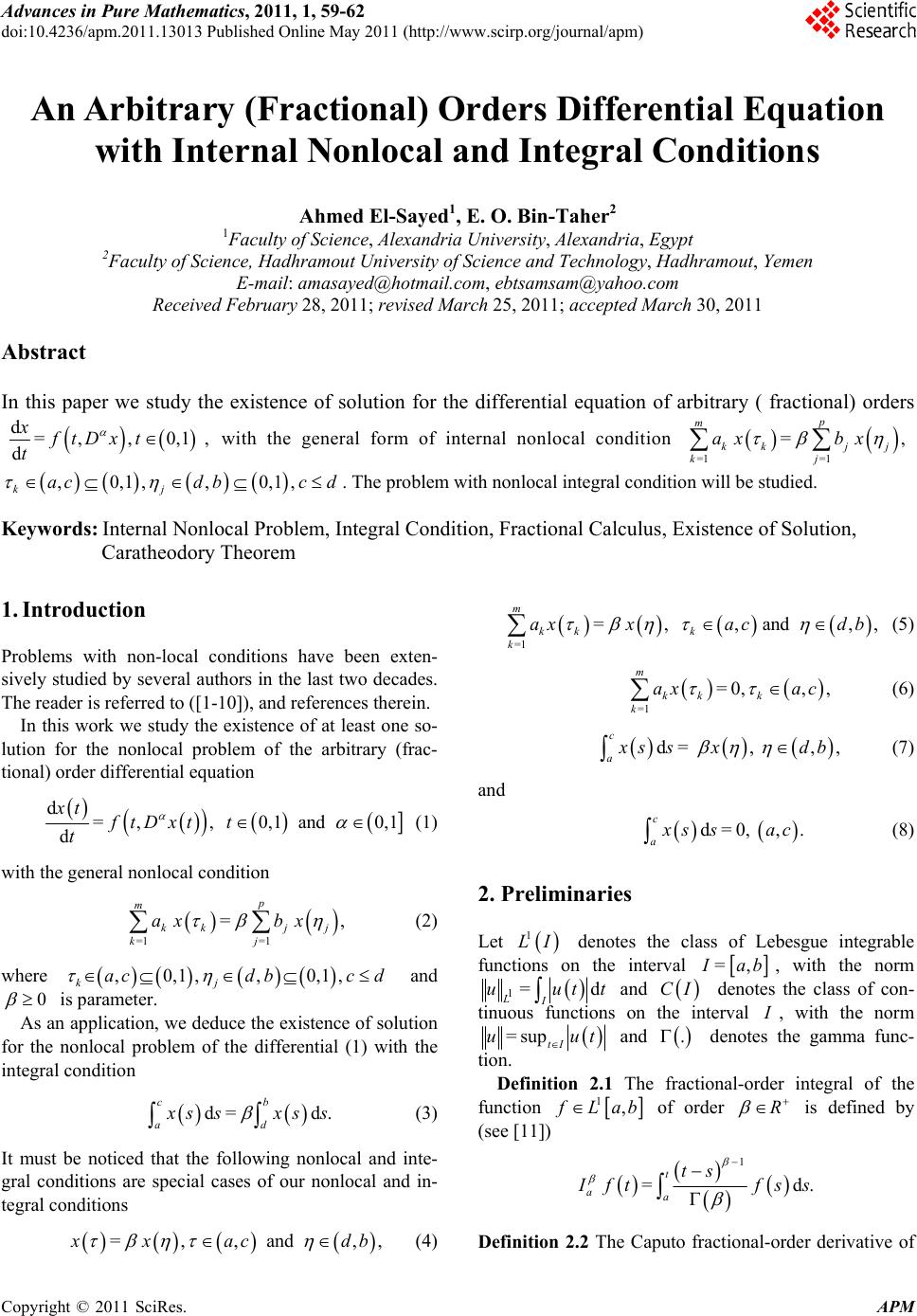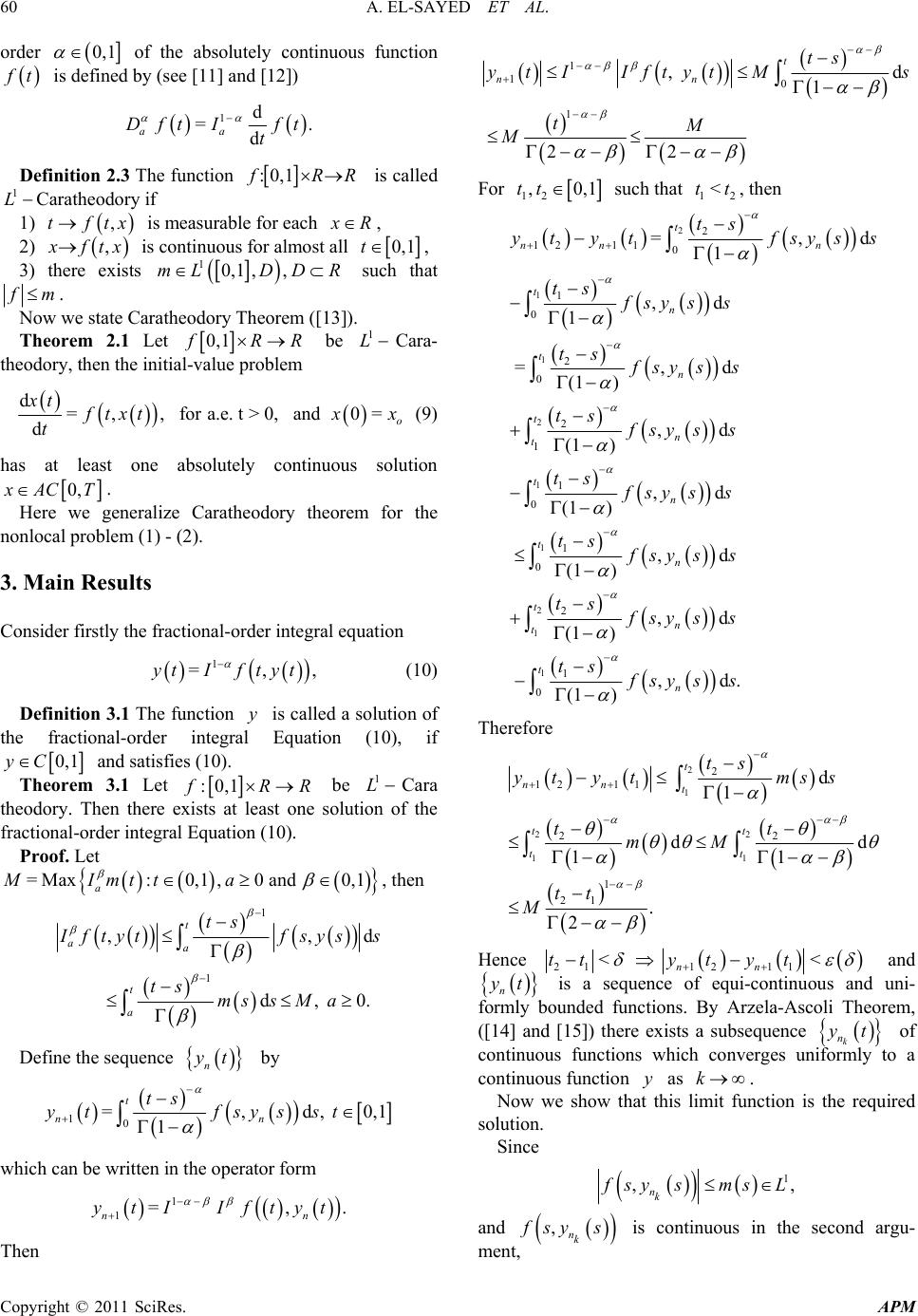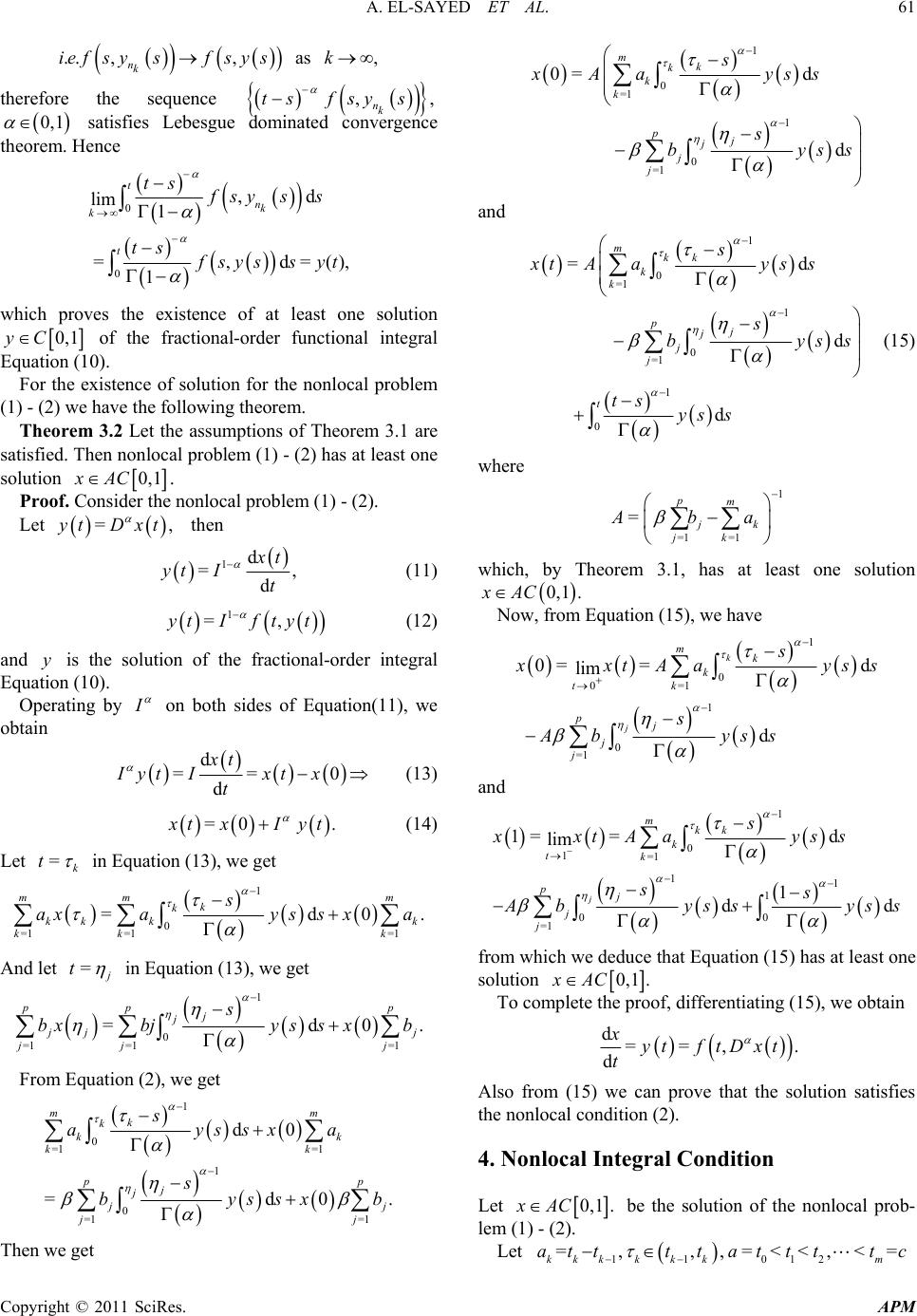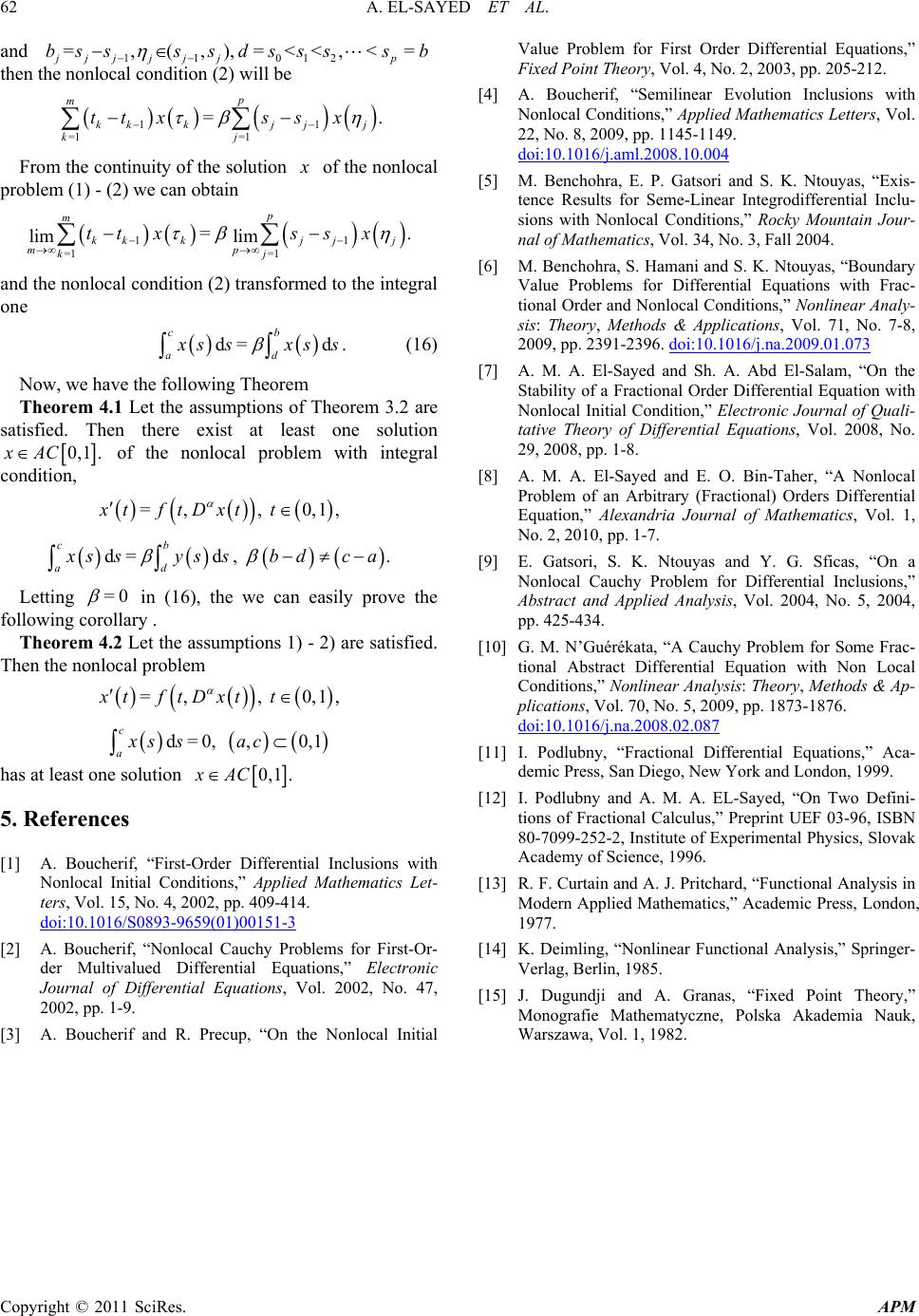Paper Menu >>
Journal Menu >>
 Advances in Pure Mathematics, 2011, 1, 59-62 doi:10.4236/apm.2011.13013 Published Online May 2011 (http://www.scirp.org/journal/apm) Copyright © 2011 SciRes. APM An Arbitrary (Fractional) Orders Differential Equation with Internal Nonlocal and Integral Conditions Ahmed El-Sayed1, E. O. Bin-Taher2 1Faculty of Science, Alexandr ia University, Alexandria, Egypt 2Faculty of Science, Hadhramout University of Science and Technology , Hadhramout, Yemen E-mail: amasayed@hotma il.com, ebtsamsam@yahoo.com Received February 28, 2011; revised March 25, 2011; acce pted Ma rc h 30, 2011 Abstract In this paper we study the existence of solution for the differential equation of arbitrary ( fractional) orders d = ,, 0,1 d xftDxt t , with the general form of internal nonlocal condition =1 =1 = , p m kkj j kj ax bx ,0,1, , 0,1, kj acdbc d . The problem with nonlocal integral condition will be studied. Keywords: Internal Nonlocal Problem, Integral Condition, Fractional Calculus, Existence of Solution, Caratheodory Theorem 1. Introduction Problems with non-local conditions have been exten- sively studied by several authors in the last two decades. The reader is referred to ([1-10]), and references therein. In this work we study the existence of at least one so- lution for the nonlocal problem of the arbitrary (frac- tional) or d er different ial equation d = ,, 0,1 and 0,1 d xt ftDxtt t (1) with the general nonlocal condition =1 =1 = , p m kkj j kj ax bx (2) where ,0,1, , 0,1, kj acdbc d and 0 is parameter. As an app lication, we deduce the ex istence of solution for the nonlocal problem of the differential (1) with the integral cond ition d = d. cb ad x ss xss (3) It must be noticed that the following nonlocal and inte- gral conditions are special cases of our nonlocal and in- tegral conditions = , , and ,, x xac db (4) =1 = , , and ,, m kk k k ax xacdb (5) =1 = 0, ,, m kk k k ax ac (6) d = , ,, c a x ss xdb (7) and d = 0, ,. c a x ss ac (8) 2. Preliminaries Let 1 LI denotes the class of Lebesgue integrable functions on the interval =, I ab , with the norm 1= d LI uutt and CI denotes the class of con- tinuous functions on the interval I , with the norm = suptI uut and . denotes the gamma func- tion. Definition 2.1 The fractional-order integral of the function 1, f Lab of order R is defined by (see [11]) 1 = d. t aa ts I ftfs s Definition 2.2 The Caputo fractional-order derivative of  A. EL-SAYED ET AL. Copyright © 2011 SciRes. APM 60 order 0,1 of the absolutely continuous function f t is define d by (se e [1 1] and [ 1 2] ) 1 d = . d aa Dft Ift t Definition 2.3 The function :0,1 f RR is called 1 LCaratheodory if 1) ,tftx is measurable for each x R, 2) , x ftx is continuous for almost all 0,1t, 3) there exists 10,1,, mLDD R such that f m. Now we state Caratheodory Theorem ([13] ). Theorem 2.1 Let 0,1 f RR be 1 L Cara- theodory, then the initial-value problem d=,, for a.e. t>0, and 0= do xt f txtx x t (9) has at least one absolutely continuous solution 0, x AC T. Here we generalize Caratheodory theorem for the nonlocal problem (1) - (2). 3. Main Results Consider firstly the fractional-order integral equation 1 = ,,ytIf tyt (10) Definition 3.1 The function y is called a solution of the fractional-order integral Equation (10), if 0,1yC and satisfies (10). Theorem 3.1 Let :0,1 f RR be 1 L Cara theodory. Then there exists at least one solution of the fractional-order integral Equation (10). Proof. Let = Max: 0,1, 0 and 0,1 a MImtta , then 1 1 , ,d d , 0. t aa t a ts I ftytfsys s ts mssM a Define the sequence n yt by 10 = , d, 0 ,1 1 t nn ts yt fsysst which can be written in the operator form 1 1 = ,. nn ytI Iftyt Then 1 10 1 , d 1 2 2 t nn ts ytIIftytMs tM M For 12 , 0,1tt such that 12 < tt, then 2 1 1 2 1 1 2 1211 0 1 0 2 0 2 1 1 0 1 0 = , d 1 , d 1 = , d (1 ) , d (1 ) , d (1 ) , (1 ) t nn n t n t n t n t t n t n ts yt ytfsyss ts fsy ss ts fsy ss ts fsy ss ts fsy ss ts fsy s 2 1 1 2 1 0 d , d (1 ) , d. (1 ) t n t t n s ts fsy ss ts fsy ss Therefore 2 1 22 11 2 12 11 22 1 21 d 1 d d 11 . 2 t nn t tt tt ts yt ytmss tt mM tt M Hence 2112 11 < < nn ttytyt and n yt is a sequence of equi-continuous and uni- formly bounded functions. By Arzela-Ascoli Theorem, ([14] and [15]) there exists a subsequence k n yt of continuous functions which converges uniformly to a continuous function y as k. Now we show that this limit function is the required solution. Since 1 , , nk f sy sms L and ,nk fsys is continuous in the second argu- ment,  A. EL-SAYED ET AL. Copyright © 2011 SciRes. APM 61 .., , as , nk iefsysfsysk therefore the sequence ,, nk tsfsys 0,1 satisfies Lebesgue dominated convergence theorem. Hence 0 0 , d lim 1 = , d = (), 1 t nk k t ts fsy ss ts fsyssyt which proves the existence of at least one solution 0,1yC of the fractional-order functional integral Equation (10). For the existence of solution for the nonlocal problem (1) - (2) we have the following theorem. Theorem 3.2 Let the assumptions of Theorem 3.1 are satisfied. Then nonlocal problem (1) - (2) has at least one solution 0,1xAC. Proof. Consider the nonlocal problem (1) - (2). Let = , yt Dxt then 1d = , d x t yt It (11) 1 = ,ytIftyt (12) and y is the solution of the fractional-order integral Equation (10). Operating by I on both sides of Equation(11), we obtain d = = 0 d xt IytIxt x t (13) = 0 . x tx Iyt (14) Let =k t in Equation (13), we get 1 0 =1 =1=1 = d0 . mm m k k kk kk kk k s axayss xa And let = j t in Equation (13), we get 1 0 =1 =1=1 = d0 . pp p j j j jj jj j s bxbjy ssxb From Equation (2), we get 1 0 =1 =1 1 0 =1 =1 d0 = d0 . mm k k kk kk pp j j j j jj s ayssxa s byssxb Then we get 1 0 =1 1 0 =1 0= d d mk k k k pj j j j s xAa yss s byss and 1 0 =1 1 0 =1 1 0 = d d d mk k k k pj j j j t s xtAayss s byss ts ys s (15) where 1 =1 =1 = pm jk jk Aba which, by Theorem 3.1, has at least one solution 0,1 .xAC Now, from Equation (15), we have 1 0 =1 0 1 0 =1 0= = d lim d k j mk k k t pj j j s x xtAayss s Ab yss and 1 0 1=1 11 1 00 =1 1= = d lim 1 d d j mk k k tk pj j j s xxtAa yss ss A byssyss from which we deduce that Equation (15) has at least one solution 0,1 .xAC To complete the proof, diffe rentiating (15), we obtain d = = ,. d xytftDxt t Also from (15) we can prove that the solution satisfies the nonlocal condition (2). 4. Nonlocal Integral Condition Let 0,1 .xAC be the solution of the nonlocal prob- lem (1) - (2). Let 11 012 =, ,, = <<,<= kkkkk km attttattttc  A. EL-SAYED ET AL. Copyright © 2011 SciRes. APM 62 and 11 012 =,(,), = <<,<= jjjjj jp bsss sdssssb then the nonlocal condition (2) will be 11 =1 =1 = . p m kkkj jj kj tt xss x From the continuity of the solution x of the nonlocal problem (1) - (2) w e can ob tain 11 =1 =1 = . limlim p m kkkj jj mp kj tt xss x and the nonlocal condition (2) transformed to the integral one d = d . cb ad x ss xss (16) Now, we have the following Theorem Theorem 4.1 Let the assumptions of Theorem 3.2 are satisfied. Then there exist at least one solution 0,1 .xAC of the nonlocal problem with integral condition, = , , 0, 1,xt ftDxt t d = d , . cb ad x ssyssbd ca Letting = 0 in (16), the we can easily prove the following corollary . Theorem 4.2 Let the assumptions 1) - 2) are satisfied. Then the nonlocal problem = , , 0, 1,xt ftDxt t d = 0, ,0,1 c axssac has at least one solution 0,1 .xAC 5. References [1] A. Boucherif, “First-Order Differential Inclusions with Nonlocal Initial Conditions,” Applied Mathematics Let- ters, Vol. 15, No. 4, 2002, pp. 409-414. doi:10.1016/S0893-9659(01)00151-3 [2] A. Boucherif, “Nonlocal Cauchy Problems for First-Or- der Multivalued Differential Equations,” Electronic Journal of Differential Equations, Vol. 2002, No. 47, 2002, pp. 1-9. [3] A. Boucherif and R. Precup, “On the Nonlocal Initial Value Problem for First Order Differential Equations,” Fixed Point Theory, Vol. 4, No. 2, 2003, pp. 205-212. [4] A. Boucherif, “Semilinear Evolution Inclusions with Nonlocal Conditions,” Applied Mathematics Letters, Vol. 22, No. 8, 2009, pp. 1145-1149. doi:10.1016/j.aml.2008.10.004 [5] M. Benchohra, E. P. Gatsori and S. K. Ntouyas, “Exis- tence Results for Seme-Linear Integrodifferential Inclu- sions with Nonlocal Conditions,” Rocky Mountain Jour- nal of Mathematics, Vol. 34, No. 3, Fall 2004. [6] M. Benchohra, S. Hamani and S. K. Ntouyas, “Boundary Value Problems for Differential Equations with Frac- tional Order and Nonlocal Conditions,” Nonlinear Analy- sis: Theory, Methods & Applications, Vol. 71, No. 7-8, 2009, pp. 2391-2396. doi:10.1016/j.na.2009.01.073 [7] A. M. A. El-Sayed and Sh. A. Abd El-Salam, “On the Stability of a Fractional Order Differential Equation with Nonlocal Initial Condition,” Electronic Journal of Quali- tative Theory of Differential Equations, Vol. 2008, No. 29, 2008, pp. 1-8. [8] A. M. A. El-Sayed and E. O. Bin-Taher, “A Nonlocal Problem of an Arbitrary (Fractional) Orders Differential Equation,” Alexandria Journal of Mathematics, Vol. 1, No. 2, 2010, pp. 1-7. [9] E. Gatsori, S. K. Ntouyas and Y. G. Sficas, “On a Nonlocal Cauchy Problem for Differential Inclusions,” Abstract and Applied Analysis, Vol. 2004, No. 5, 2004, pp. 425-434. [10] G. M. N’Guérékata, “A Cauchy Problem for Some Frac- tional Abstract Differential Equation with Non Local Conditions,” Nonlinear Analysis: Theory, Methods & Ap- plications, Vol. 70, No. 5, 2009, pp. 1873-1876. doi:10.1016/j.na.2008.02.087 [11] I. Podlubny, “Fractional Differential Equations,” Aca- demic Press, San Diego, New York and London, 1999. [12] I. Podlubny and A. M. A. EL-Sayed, “On Two Defini- tions of Fractional Calculus,” Preprint UEF 03-96, ISBN 80-7099-252-2, Institute of Experimental Physics, Slovak Academy of Science, 1996. [13] R. F. Curtain and A. J. Pritchard, “Functional Analysis in Modern Applied Mathematics,” Academic Press, London, 1977. [14] K. Deimling, “Nonlinear Functional Analysis,” Springer- Verlag, Berlin, 1985. [15] J. Dugundji and A. Granas, “Fixed Point Theory,” Monografie Mathematyczne, Polska Akademia Nauk, Warszawa, Vol. 1, 1982. |

